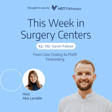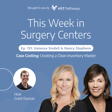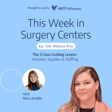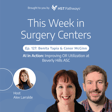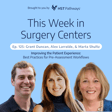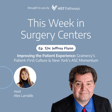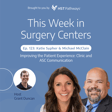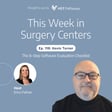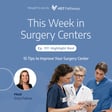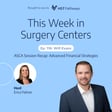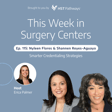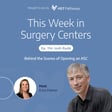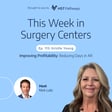Become a Creator today!Start creating today - Share your story with the world!
Start for free
00:00:00
00:00:01

Maximizing OR Utilization in Ortho ASCs
This week, ASC expert Carol Hiatt joins us to share practical tips for improving OR utilization in orthopedic surgery centers. With over 30 years in the industry, Carol dives into common causes of underutilization and how to fix them.
Then in our Data & Insights segment, we spotlight dental ASCs. Drawing from 35 facilities and over 15,000 cases, we break down key metrics like block utilization, pre-auth rates, and patient deposit collection.
Resources Mentioned:
https://www.hstpathways.com/specialty-data/dental
Brought to you by HST Pathways.
Transcript
Podcast Introduction
00:00:01
Speaker
Welcome to This Week in Surgery Centers. If you're in the ASC industry, then you're in the right place. Every week, we'll start the episode off by sharing an interesting conversation we had with our featured guest.
00:00:12
Speaker
And then we'll close the episode by recapping the latest news impacting surgery centers. We're excited to share with you what we have. So let's get started and see what the industry's been up to.
Maximizing OR Utilization
00:00:28
Speaker
Hi, everyone. Here's what you can expect on today's episode. As the founder and owner of Surgery Center Consulting Services, Carol Hyatt is an ASC industry veteran with over 30 years of firsthand experience.
00:00:42
Speaker
Carol joins us this week to share tips on how orthopedic centers can increase and maximize OR utilization. So if you're looking for ways to improve this metric and avoid common causes of underutilization, then you will love this episode and will definitely walk away with lots of tangible tips.
00:00:59
Speaker
After my conversation with Carol, we'll switch to our data and insight segment. You're likely familiar with our full State of the ASC industry report, but we've recently released 12 new benchmarking reports that are shorter and solely focused on the data and really take a deeper dive into one single specialty at a time.
00:01:18
Speaker
So today I want to pay some attention to dental facilities. I feel like this is a specialty that can often be overlooked sometimes, but we were able to pull data from 35 centers representing nearly 15,600 unique cases.
00:01:33
Speaker
So we'll look at block utilization, pre-auth rates, patient deposit collection rates, and a bunch more. I hope everyone enjoys the episode and here's what's going on this week in Surgery Centers.
Carol Hyatt's Introduction
00:01:48
Speaker
Hi, Carol. Welcome to the podcast. Hi, Erica. Great to be here. Can you please share a little bit about yourself with our listeners? Sure. So my name is Carol Hyatt.
00:01:59
Speaker
I'm a registered nurse. I'm also a certified operating room nurse, a certified ambulatory surgery center administrator, and a certified professional healthcare risk manager. I grew up in the ambulatory surgery center business. I have been in here, as you can tell by my hair, a long time, enough time that I've got plenty of ASC wisdom.
00:02:20
Speaker
For the last, I think it's about Gosh, I hate to say this, but i think it's 17 or 18 years. I've also been an accreditation surveyor. So I do a lot of new surgery center startups.
00:02:32
Speaker
I spend a lot of time helping surgery centers stay in compliance. And I'm also recently, there's been a tremendous ask for help with efficiency in operating rooms. So I'm doing a lot of focusing on that right now.
00:02:46
Speaker
So I have a real broad stroke of the industry, but a lot of depth and a lot of history.
OR Utilization Challenges in Orthopedic Centers
00:02:54
Speaker
Yes, and that is why I'm very excited to have you on today because we were talking a few weeks ago and you had mentioned the project you're currently working on, which is working with the surgery center, an ortho facility to help them maximize their OR utilization.
00:03:10
Speaker
and I said, I'm gonna stop you right there. Can you please come on the podcast and tell us everything? So let's get right into it. Why is OR utilization such a high impact metric specifically for ortho centers?
00:03:25
Speaker
So it's a high impact metric for every surgery center. I was lucky enough to cut my teeth in GI and um ophthalmology. I didn't know that was lucky. I just thought it was a lot of hard work, but those two specialties cannot survive unless they are successful with high volume and very efficient turnover.
00:03:48
Speaker
So that's how I learned. And I learned quickly what I had to do to make those centers efficient. So as I grew up in the industry and went on to spine and orthopedics and other specialties, I realized that even though those specialties often made a lot more money for their cases, they were leaving a lot on the table.
00:04:12
Speaker
OR utilization is it' the key to profitability. Right now in our industry, as everyone that's listening to this knows, most ASCs are paying anesthesia subsidies.
00:04:24
Speaker
And some of them are huge, even millions a year in some of these orthopedic surgery centers. In addition, anesthesia has got a high burnout rate right now. And I hate to use the word hostage, but a lot of those anesthesia groups are setting their own parameters because they're paid on a stipend and not necessarily incentivized by being an employee and making bonus through volume and things like that.
00:04:51
Speaker
So sometimes they're limiting the length of day, the number of cases and re reimbursement for anesthesia is down. So if we're not running our ORs efficiently and using them for what they are intended for a high percent of the time, then we're not going to be successful and anesthesia not going to be successful.
00:05:13
Speaker
Sure. Yeah. And I think I had shared this, but in HST's State of the Industry report, we had found that on average, ortho ASCs specifically are only using 35% of their blocked OR time. Now that was for 2024.
00:05:29
Speaker
What are some of the most common causes, in addition to what you've shared, that you're seeing for underutilization? Yeah. As I've mentioned to you before, I didn't even look at your study results before I dove in on a few of my facilities to look at where they were.
00:05:46
Speaker
And 35% is generous, unfortunately. And these are very large, very successful orthopedic groups whose names are very recognizable.
00:05:56
Speaker
A couple of them, their OR utilization was even below 35. They now understand how much money they're leaving on the table and how catastrophic it is for them.
00:06:07
Speaker
But at the time, they couldn't quite put their finger on the pulse. First and foremost, not knowing your number and the national benchmarks you should be striving to achieve.
00:06:19
Speaker
is very, that is so key. And I was surprised with two of these large groups. They didn't know their number and, and they're even members of ortho forum.
00:06:31
Speaker
So even if they knew what the benchmarks were, they didn't yet, they hadn't gathered their data and they didn't know how they compared to the benchmarks. One of the things I discovered when big groups start looking at an easy metric, what percent of your surgical cases for the whole practice are going to the hospital?
00:06:52
Speaker
Well, in the groups that I've been looking at, I'm finding 30 to 40% of their cases are being sent to the hospital rather than captured in their own ASC. According to OrthoForum, that number should be 10 to 20.
00:07:05
Speaker
So reserving those hospital cases for the patients that really have a higher ASA acuity or need inpatient care, that 20% or more represents a significant loss of ASC volume and revenue.
00:07:22
Speaker
One of the
Strategies for Retaining Cases in ASCs
00:07:23
Speaker
recommendations I give for this is that the group form a committee, ah surgeons and anesthesia providers that every month sit down and retrospectively review the cases that were sent to the hospital.
00:07:35
Speaker
Susan J. The first thing they have to do, I should back up and say is they have to establish criteria, so this criteria and they need to agree on it anesthesia and surgeons, this is the criteria.
00:07:48
Speaker
for patients that should be sent out for the hospital. And believe it or not, this doesn't necessarily have some things in there you might expect. Like I've been with some groups that are saying, okay, our cutoff is 85.
00:08:01
Speaker
Why? There doesn't need to be an upper end if the patient is healthy. So what they need to do is sit down and look at a lot of the published criteria that's out there and determine criteria that they're gonna go by.
00:08:13
Speaker
Then every month they sit down, they review the cases that went to the hospital, And if there are cases that are falling out that didn't match that criteria, they need to educate their providers and continue to coach the providers until they recapture those cases that should be going to their ASC.
00:08:33
Speaker
As long as you're not having a significant increase in transfers or other indicators like that, then there's no reason not to keep those cases at the ASC.
00:08:46
Speaker
Statistically, they should have a lower chance of getting an infection, and patients are happier with the quality of care they get in the ASC.
Role of Urgent Care in Orthopedic Groups
00:08:54
Speaker
Yeah, I love that. You don't have to do any extra work to to secure those patients. So it's not like we're saying, okay, we want to increase our volume or increase the patients at the practice.
00:09:05
Speaker
They're already there. We're just reassigning where they're going. So I think that's great. Just capture what we already have. Put them in the right bucket, so to say. Love it. Yeah. Another way that ortho groups, and this is really interesting. So in the last few years, ortho groups, a lot of them as they've developed their own ASCs have stopped taking ER call or have been pushed out of ER r call because the hospitals are so hiring their own hospitalists to capture and maintain those encounters of care.
00:09:39
Speaker
A lot of ortho groups have realized, Hey, we need to find our way into that urgent care market. But with in the case of a few of these groups that I'm working with, I've worked with another group whose marketing was excellent.
00:09:54
Speaker
And I'm not going to use their name here, but they do an excellent job. Their message is clear. I flew to go see them. the time I got out of the airport, I had already seen two billboards that had I torn my rotator cuff on that trip, I would have known where to go to get urgent care for my rotator cuff.
00:10:13
Speaker
They had signs in the airport and the message was clear. It wasn't fuzzy. It wasn't acute care injury. It was really clear. it was for urgent care for orthopedic type injuries.
00:10:27
Speaker
And that particular group keeps 18 ORs in a mid-market area full to capacity near. Wow.
00:10:37
Speaker
because they're driving their own volume by capturing that first encounter care. They're capturing that road warrior that's traveling around or that's out running after work.
00:10:49
Speaker
But the way they've done it is they just develop a clear urgent care market and then they extend some hours at the office so that they have some evening our and some weekend hours. And they're capturing that first injury, getting them even into conservative care in their own practice, like physical therapy and things like that.
00:11:09
Speaker
And then ultimately, if they need surgery, they retain that patient and they get into their OR. That's exactly what the hospitals are doing. And they're pushing those groups out. So if the groups don't make their own direct to consumer marketing program and do it well, they're not going to be able to keep compete and they're going continue to lose market share to those hospitals.
00:11:32
Speaker
And that's a really powerful tool. You're speaking my language, Carol.
Key OR Efficiency Metrics
00:11:39
Speaker
Okay, so there a lot of measures of OR efficiency that I've been surprised to see that these ASCs don't even know. So we talk about a number and everybody's heard block utilization, but they don't really even know what their number is and they're not comparing it to anything meaningful.
00:11:58
Speaker
So block utilization means if you have Dr. Smith and he's blocked eight full days a month, what percent of those full days is he actually using for scheduling cases?
00:12:11
Speaker
According to OrthoForum, that number should be 85%. So in my experience, so in my experience the OR block time utilization is really low, less than 50% a lot of times, and nobody's monitoring and doing anything about it.
00:12:28
Speaker
There can be a lot of causes for that. There can be that the doctor is not accurately estimating his case time. Doctors should be able to accurately estimate their case time 90% of the time. What does that mean?
00:12:42
Speaker
That means it's plus or minus 20% of the time that they predict it will take. So if a case should take 60 minutes, that means it's plus or minus 12 minutes.
00:12:53
Speaker
That's accurate case time. And if he's not consistently accurate, then someone should be going to him and saying, we need to adjust your cases and your projected times.
00:13:04
Speaker
Now, there he can always schedule exceptions. A lot of times what I find is someone in the practice is determining how long they think those cases will take, and that's how long they're scheduling them for. That's a very inefficient way to do it, rather than someone at the surgery center saying, okay, historically, this is how long it takes.
00:13:24
Speaker
That's a really important
Improving OR Efficiency
00:13:25
Speaker
place to start is block utilization, because that time that's unused needs to be given away. The next important metric is the one you already talked about, and that's OR utilization. So that means of the percentage of time that the OR is available, what percent is it actually being utilized for surgery and direct patient care?
00:13:49
Speaker
According to OrthoForum, as well as other best in class benchmarks, that number should be 75 to 85% of the time. And as you already mentioned, y'all found it to be 35. I found it to be even less most of the time.
00:14:05
Speaker
So that has a lot of ramifications because then you get into staff efficiency and There are a lot of things that can affect that.
00:14:18
Speaker
But one of the most important indicators is how many cases, like, so a lot of times I talk to doctors. I told you I do a lot of new surgery center startup. I say, how many ORs do you plan to start out with?
00:14:31
Speaker
And they'll tell me, oh, four to six. And I'll say, how many cases do you plan to bring? And they say, oh, 2,000. So they should be opening two ORs max.
00:14:42
Speaker
Instead, they're open in four. So they're never going to be efficient. None of these benchmarks are ever going to be met because they've got too many ORs open. So one of the benchmarks you should be looking at 1,000 cases year.
00:14:57
Speaker
per o r per year Some surgery centers, orthopedic and spine, believe it or not, are hitting benchmarks as high as 1,800 cases per year per OR. Wow. So that's astounding.
00:15:11
Speaker
That's astounding. If you're not hitting at least 1,000, you should be closing ORs until you are operating efficiently out of fewer ORs.
00:15:22
Speaker
Then increase your ORs as your volume increases.
00:15:27
Speaker
Another important indicator is cancellations or cancellations day of surgery should be less than 2%. If they're more than that, again, the recommendation that I gave for the anesthesia group review or the hospital case review, have that same committee take a look at day of surgery cancellations and see could this have been prevented? How could we do this? Until you get your number below 2%.
00:15:53
Speaker
Another number that you need to know is what your staff costs per case. I'm not talking about anesthesia right now. I'm just talking about your total payroll plus total benefits for employees of the ASC.
00:16:07
Speaker
What does it cost you per case right now to do your cases? So according to all the studies, ortho forum, benchmarks, ASCA did a study that they published in 2017 that they said it should be per case.
00:16:23
Speaker
So we all know it salaries have gone up exponentially. So even if it's 40% higher and it's $700 per case, I'm seeing twice that at most centers because they have too many ah ORs and they're underutilized block time and things like that.
00:16:41
Speaker
You got to know those numbers going into a lot of these efficiency studies. these centers don't even know their numbers, even though they have the ability to calculate a lot of these things out of something like HST.
00:16:56
Speaker
They don't know how to use it or they haven't fully utilized it, or just frankly don't have the time to get granular and figure this out to help them figure out where they are.
00:17:08
Speaker
As far as simple things centers can start with, One of the things that really shocked me is one of the first efficiency studies I did at a really big orthopedic group in Wisconsin.
Setting and Monitoring Cut Times
00:17:23
Speaker
I went in and I said, so what's your cut time?
00:17:26
Speaker
And they looked at me like, what? I said, when do you start? They said, oh we roll in at, I said, no, not, what are you aiming for?
00:17:37
Speaker
What the And I was surprised out of a large number of surgeons, no one had a cut time. I said, that's like trying to shoot for a goal that you don't even know what it is.
00:17:51
Speaker
So you need to establish your cut time. The surgeon, you go to the surgeon and say, doc, we'd like to see you cut at 730. Is that okay? He says, yes. That means you want his belly to the table at 730.
00:18:04
Speaker
So it's the team's responsibility to determine how do we get there? Do we have to get in there 45 minutes early? Do we need to get in there 30 minutes early? What is it going to take us to get ready?
00:18:14
Speaker
That's a simple place to start. And then monitor those first case on time starts. That's when you start measuring things and then giving feedback to the providers and the surgeons.
00:18:28
Speaker
It changes everything. By nature, surgeons are super competitive. When they see their numbers up in front of everybody and compared to everybody else, oh everything's on the table at that point.
00:18:41
Speaker
That number, first case on time starts, according to OrthoForum and Rothman Institute and several other very reputable places should be greater than 95% first case.
00:18:56
Speaker
What does that mean? That means that first case starts within five to 10 minutes of the scheduled cut time. So if it's 7 30 within five to 10 minutes before after that time, either way can be fine.
00:19:10
Speaker
And then
Achieving OR Efficiency Goals
00:19:11
Speaker
on time, case starts through the rest of the day should be greater than 90%. And that's a formidable goal.
00:19:22
Speaker
A lot of times when I talked about the surgeon estimate of how long it would take him to do his case, if their estimates are off, you'll never have an on-time case start of 90% because they're missing the mark all day long.
00:19:38
Speaker
So you've got to make sure that they're estimating their time accurately. Another thing they can do is I find a lot of centers, the doctors are doing half days, which they come in they want to come in, do surgery first thing in the morning, and then go to clinic in the afternoon. I'm seeing at one center I was at recently, just in the morning from the end of cases till the afternoon cases started, they spent $4,500 on staff
00:20:10
Speaker
salaries while the ORs sat idle. If you do that five days a week, 52 weeks out of the year, you're losing millions of dollars.
00:20:21
Speaker
The most effective way is almost always full surgical days. it's There's the rare exceptions, but it should be the exception, not the rule. And then, like I said before, keep looking at those block times. So if you give them three full days and they can't fill them up, give them two full days.
00:20:41
Speaker
Now I haven't even talked about things like whether you want to do flipped rooms or surgeons following it themselves in one room. I haven't talked about specifically turnover times. That's another really important indicator.
00:20:56
Speaker
but it's a little bit more than the scope of our talk for today. I could get into more, but those are also things you need to know, you need to measure, you need to monitor, and you need to tell the staff what the goal is.
00:21:09
Speaker
So one of the things that I have my centers do is develop a facility scorecard that tracks all these things that I'm talking about. And initially, you have to do it every month.
00:21:21
Speaker
Keep putting the data in front of them and saying, this is where we are This is the goal. This is where we are. This is the goal. Eventually, you'll get to where you can look at it every quarter. And then eventually, you will have to monitor that frequently.
00:21:34
Speaker
But that's crucial piece of how you get from where you are to where you need to be. And then finally, i would say that if you do all these things and you still have underutilized rooms, like one center I'm working with, they, I don't want to say arbitrarily, but they're set up on half days, five hours in the morning, five hours in the afternoon. So they have 10 hour days.
00:22:03
Speaker
They need to go to full day blocks right now. And they need to decrease the length of their days to eight or nine hours. because they're not utilizing their block time, but less than, like I said, 32%.
00:22:17
Speaker
So there's a lot of tools in your tool belt that you can do to improve your OR efficiency, but you really have to study it and get in and know your numbers. That's amazing that all of that advice, I think, even if someone could walk away and do two or three of those suggestions to start.
00:22:35
Speaker
ah And because that's what, especially when it comes to data, we're always trying to tell people, you don't have to do it all, all at once, because if you're not doing it right now, it can seem so intimidating and taking.
00:22:47
Speaker
one step. Okay, let's start tracking one of the metrics you shared. Okay, next month or next quarter, we're going to start tracking two. And just those incremental improvements, even going from 32% 35% to to dollars. So to forty one could be millions of dollars so 100%, Erica, 100%.
00:23:07
Speaker
hundred percent And you're right, it does, it will feel daunting. This isn't a one month project. It's not a six month project. This is year long project at best.
00:23:21
Speaker
And that is looking at it every month, every quarter. And you're always going to be tweaking it. You may even find you need to tweak these things seasonally. You may find that the summer months are really slow, so you need to close another OR.
00:23:35
Speaker
And those are things that you really have to look at. How can i do this And you'd be surprised a lot of times for the summer, if you offer staff additional time off without pay, they'll jump at the opportunity because they really want to be off with their kids for the summer.
00:23:52
Speaker
Everybody's situation is different and everyone is staffed differently. Once you start measuring even a few things, it will drive your hunger to know more.
00:24:04
Speaker
And then you'll want to measure more things. And as you master certain areas, then you can move on to the next. I hope this is
Importance of Knowing Your Numbers
00:24:11
Speaker
helpful. I hope I didn't give you so much that everybody's so overwhelmed they don't do anything. At least if you don't have cut times, establish cut times.
00:24:19
Speaker
If all you do is establish cut times and start monitoring your block utilization and maybe your room turnover, which I'll go ahead and say out there, Room turnover should be 20 minutes or less. And it does matter whether you're following in one room or flipping. If you're flipping, you better be able to get that doctor's belly to the next table in under 15 minutes or you're not there's no reason to flip.
00:24:45
Speaker
If you can't do that, a recent client I've been looking at, they weren't even rolling in the next patient till the surgeon was closing. That's way too late. They need to be ready with the next patient if they're flipping rooms, so When he closes, he needs to be able to walk out, do his five minutes worth of things and be ready to go to the next next case.
00:25:07
Speaker
But there are few, if that's all, if you only focus on those things, room turnover, first cuts, block utilization, you'll vastly improve the efficiency of your surgery center.
00:25:20
Speaker
Perfect. You have already given us so much advice, but we do this every week with our guests. What is one thing our listeners can do this week to improve their surgery centers?
00:25:33
Speaker
Start measuring where you are against where you should be. Learn what your numbers are and learn where you need to go. Because if you don't have a goal and you don't know where you are, then it's going to be a frustrating thing.
00:25:46
Speaker
That's the most important thing I believe that our listeners can do. Start measuring where you are, comparing to where you want to go and start taking incremental steps. Perfect. Thank you so much for coming on today. We really appreciate it.
00:26:01
Speaker
Thank you for having me, Erica. It was great. I always love working with you. enjoyed this opportunity. Thank you. Feelings are mutual. Thank you.
Review of Dental Facility Metrics
00:26:15
Speaker
HST Pathways released 12 benchmarking reports, with each report taking a deep dive into one single specialty at a time, comparing data from 2023 to 2024. Using our own unique data set from our clients, we were able to extract data points so that anyone in the industry could compare themselves to their peers.
00:26:34
Speaker
Two quick disclaimers, we only pulled data from clients who gave us permission and we omitted any extreme outliers. So today want to take a look at 10 metrics for dental cases and facilities.
00:26:46
Speaker
The data I'm going to share next represents 15,610 unique dental cases across 35 centers. and ten unique dental cases across thirty five centers So the first metric is OR block utilization.
00:26:58
Speaker
Operating room utilization held steady, dipping just slightly from 56% to 55% from 2023 to 2024. Now that may not sound like much, but there's still a big opportunity here as a well-utilized OR should be hitting at least 70% usage.
00:27:17
Speaker
The second metric is pre-authorization rates. So those dropped from 37% to 31% from 2023 to 2024, which is definitely a huge red flag.
00:27:29
Speaker
Performing a case without proper auth is one of the fastest ways to delay or lose reimbursement. So even if the doctor's office says they've handled it, the ASC really needs to double check. And the best way to do that is by using integrated payer tools.
00:27:43
Speaker
The third metric is insurance verification rates. So rates dipped from 94% to 85% from 2023 to 2024. The silver lining is that it's still above the industry average, but unfortunately heading in the wrong direction.
00:27:58
Speaker
Now, 94% insurance verification rate in 2023 is insanely good. So there definitely was a little wiggle room there. But you really want to rerun checks at least twice, once at case acceptance and again the morning of surgery.
00:28:13
Speaker
And if you have a fully automated system, which you definitely should, you also can run insurance verification checks again on the first of every month and of course the first of the year as well.
00:28:25
Speaker
The fourth and fifth metrics I want to look at focus on case cancellations. So great news here. Cancellations did drop year over year from 25% to 23%. It's still high, but definitely moving in the right direction.
00:28:39
Speaker
And when we look at why cancellations are happening, about 30% were patient driven. There's only so much you can do there. And another 25% were health related. The rest, though, were often preventable.
00:28:52
Speaker
So we're talking missing labs, scheduling errors, or internal missteps. So track those reasons closely as they're one of your best levers to improve utilization and reduce revenue loss.
00:29:04
Speaker
All right, the sixth metric is patient deposit collection rates. So upfront collections improved, which is awesome, jumping from 70% 74%, which of course, solid win. which is of course a solid win If this is a metric you're working to improve, keep in mind that patients are more likely to pay when they know exactly what to expect. So send those accurate, easy to read estimates one to two weeks before the procedure.
00:29:28
Speaker
And using text or email and making it super easy for patients pay online in installments will also help.
00:29:36
Speaker
The seventh metric is days to bill. So billing turnaround got faster, which is fantastic, dropping from 12 days in 2023 to eight days in 2024. That is a major efficiency gain.
00:29:49
Speaker
So to keep this up, just make sure your EHR and billing systems are integrated, coders are well-trained, and that you're tracking denials closely. And speaking of denials, let's talk about claim denial rates. So here's where we saw the biggest concern, unfortunately.
00:30:04
Speaker
Claim denials jumped from 6% 13%.
00:30:08
Speaker
And without that clean claim process, you will experience tons of issues trying to get paid. Relying on connected systems for charge entry and claim submission does reduce errors, but you also need a regular denial review process to catch and correct patterns quickly.
00:30:25
Speaker
And this can definitely be one that you can review in your quarterly board meetings as well if you do see it trending in a direction you don't want it to go. Speaking of metrics you should be reporting on in your quarterly board meetings, net revenue per case.
00:30:39
Speaker
So net revenue per case for dental procedures rose from $1,566 to $1,696, which is an 8% increase, which we always love to see.
00:30:53
Speaker
So in order to keep this trending positively, you want to use analytics to review those financial performance monthly, track trends, and identify where costs can be controlled. And lastly, let's talk about case volume.
00:31:07
Speaker
So case volume went up from 59 to 69 average monthly cases, which is awesome and definitely a meaningful jump in demand. So there you have it, 10 metrics specific to dental surgery centers.
Conclusion and Call to Action
00:31:20
Speaker
Now, if you're a visual learner or you want to see the same data for 11 other specialties, head to the link in the podcast episode notes to see the data itself and the written explanation as well.
00:31:32
Speaker
And that officially wraps up this week's podcast. Thank you, as always, for spending a few minutes of your week with us. Make sure to subscribe or leave a review on whichever platform you're listening from. I hope you have a great day and we will see you again next week.

